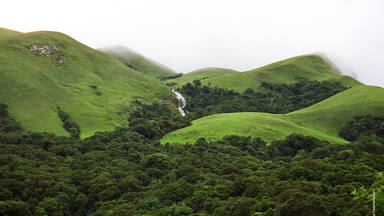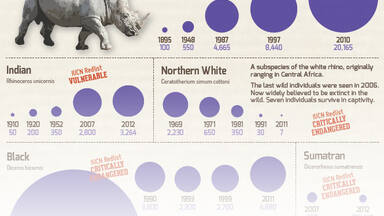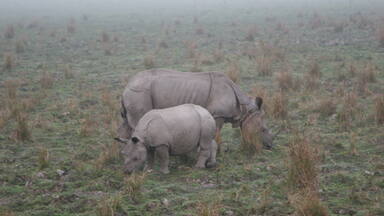Manas Wildlife Sanctuary
Manas Wildlife Sanctuary
On a gentle slope in the foothills of the Himalayas, where wooded hills give way to alluvial grasslands and tropical forests, the Manas sanctuary is home to a great variety of wildlife, including many endangered species, such as the tiger, pygmy hog, Indian rhinoceros and Indian elephant.
Description is available under license CC-BY-SA IGO 3.0
Sanctuaire de faune de Manas
Dans une zone des contreforts de l'Himalaya où alternent collines boisées, prairies alluviales et forêts tropicales, le sanctuaire de Manas abrite une faune d'une extrême richesse qui comprend de nombreuses espèces menacées, comme le tigre, le sanglier nain, ainsi que le rhinocéros et l'éléphant indiens.
Description is available under license CC-BY-SA IGO 3.0
موئل ماناس للحيوانات
يضمّ ملاذ ماناس الواقع في منطقة في خاصرة جبال الهملايا حيث تتناوب تلال مشجرة ومروج طمييّة وغابات استوائية، ثروةً حيوانية غنية للغاية تشمل العديد من الأجناس المهدّدة كالنمر والخنزير القزم، بالإضافة إلى وحيد القرن والفيل الهنديّين.
source: UNESCO/CPE
Description is available under license CC-BY-SA IGO 3.0
马纳斯野生动植物保护区
马纳斯野生动植物保护区位于喜马拉雅山脚下一个平缓的斜坡上,这里由一片冲积草原和热带森林构成,是许多野生动物的家园。保护区内生活着许多濒危物种,如老虎、小矮猪、印度犀牛和印度象。
source: UNESCO/CPE
Description is available under license CC-BY-SA IGO 3.0
Убежище дикой фауны Манас
На пологих склонах в предгорьях Гималаев, где покрытые лесом холмы соседствуют с тростниковыми зарослями и тропическим лесом, отмечено исключительное разнообразие диких животных, включая множество редких и исчезающих видов, таких как тигр, карликовая дикая свинья, однорогий носорог и индийский слон.
source: UNESCO/CPE
Description is available under license CC-BY-SA IGO 3.0
Santuario de fauna de Manas
Situado en una zona de colinas boscosas, praderas aluviales y bosques tropicales que se extiende por una suave pendiente de la falda del Himalaya, el santuario de Manas alberga una fauna muy variada que comprende numerosas especies en peligro de extinción, como el tigre, el rinoceronte indio, el cerdo pigmeo, y el elefante indio.
source: UNESCO/CPE
Description is available under license CC-BY-SA IGO 3.0
マナス野生生物保護区
source: NFUAJ
Wildreservaat Manas
Op een lichte helling aan de voet van het Himalaya gebergte – waar de beboste heuvels ruimte maken voor aangeslibde graslanden en tropische wouden – ligt het toevluchtsoord voor wilde dieren ’Manas’. Het gebied herbergt een enorme variëteit aan wilde dieren, waaronder een groot aantal bedreigde diersoorten, zoals de tijger, het pygmee varken, de Indische neushoorn en de Indische olifant. Het park bevindt zich in de staat Assam in noordoost India, een echte hotspot wat biodiversiteit betreft. Het gebied beslaat 39.100 hectare – waar de rivier de Manas deel van uitmaakt – en grenst in het noorden aan Bhutaan.
Source: unesco.nl
मानस वन्यजीव अभ्यारण्य
हिमालय की तलहटी में हल्की ढलान पर, जहां जंगली पहाड़ियां से होकर, जलोढ़ घास के मैदानों और उष्णकटिबंधीय जंगलों का रास्ता है, ऐसा मानस अभयारण्य कई प्रकार की लुप्तप्राय प्रजातियों, जैसे कि बाघ, पिग्मी हॉग, भारतीय गैंडों और भारतीय हाथी सहित कई प्रकार के वन्यजीवों का निवास स्थान है।
Source: India
Outstanding Universal Value
Brief synthesis
Manas Wildlife Sanctuary is located in the State of Assam in North-East India, a biodiversity hotspot. Covering an area of 39,100 hectares, it spans the Manas river and is bounded to the north by the forests of Bhutan. The Manas Wildlife Sanctuary is part of the core zone of the 283,700 hectares Manas Tiger Reserve, and lies alongside the shifting river channels of the Manas River. The site’s scenic beauty includes a range of forested hills, alluvial grasslands and tropical evergreen forests. The site provides critical and viable habitats for rare and endangered species, including tiger, greater one-horned rhino, swamp deer, pygmy hog and Bengal florican. Manas has exceptional importance within the Indian sub-continent’s protected areas, as one of the most significant remaining natural areas in the region, where sizeable populations of a large number of threatened species continue to survive.
Criterion (vii): Manas is recognized not only for its rich biodiversity but also for its spectacular scenery and natural landscape. Manas is located at the foothills of the Eastern Himalayas. The northern boundary of the park is contiguous to the international border of Bhutan manifested by the imposing Bhutan hills. It spans on either side of the majestic Manas river flanked in the east and the west by reserved forests. The tumultuous river swirling down the rugged mountains in the backdrop of forested hills coupled with the serenity of the alluvial grasslands and tropical evergreen forests offers a unique wilderness experience.
Criterion (ix): The Manas-Beki system is the major river system flowing through the property and joining the Brahmaputra river further downstream. These and other rivers carry an enormous amount of silt and rock debris from the foothills resulting from the heavy rainfall, fragile nature of the rock and steep gradients of the catchments. This leads to the formation of alluvial terraces, comprising deep layers of deposited rock and detritus overlain by sandy loam and a layer of humus represented by bhabar tracts in the north. The terai tract in the south consists of fine alluvial deposits with underlying pans where the water table lies near to the surface. The area contained by the Manas-Beki system gets inundated during the monsoons but flooding does not last long due to the sloping relief. The monsoon and river system form four principal geological habitats: Bhabar savannah, Terai tract, marshlands and riverine tracts. The dynamic ecosystem processes support broadly three types of vegetation: semi-evergreen forests, mixed moist and dry deciduous forests and alluvial grasslands. The dry deciduous forests represent an early stage in succession that is constantly renewed by floods and is replaced by moist decidous forests away from water courses, which in turn are replaced by semi evergreen climax forests. The vegetation of Manas has tremendous regenerating and self-sustaining capabilities due to its high fertility and response to natural grazing by herbivorous animals.
Criterion (x): The Manas Wildlife Sanctuary provides habitat for 22 of India’s most threatened species of mammals. In total, there are nearly 60 mammal species, 42 reptile species, 7 amphibians and 500 species of birds, of which 26 are globally threatened. Noteworthy among these are the elephant, tiger, greater one-horned rhino, clouded leopard, sloth bear, and other species. The wild buffalo population is probably the only pure strain of this species still found in India. It also harbours endemic species like pygmy hog, hispid hare and golden langur as well as the endangered Bengal florican. The range of habitats and vegetation also accounts for high plant diversity that includes 89 tree species, 49 shrubs, 37 undershrubs, 172 herbs and 36 climbers. Fifteen species of orchids, 18 species of fern and 43 species of grasses that provide vital forage to a range of ungulate species also occur here.
Integrity
The property is a wildlife sanctuary with a focus on maintaining the integrity of the property as a natural area. It forms the core of a larger national park, the boundaries of which are clearly demarcated and supervised. Manas Wildlife Sanctuary is buffered on the north by the Royal Manas National Park of Bhutan and on the east and west less effectively by the Manas Tiger Reserve. Transboundary cooperation is therefore important to the effectiveness of its protection.
Protection and management requirements
The property, which has six national and international designations (i.e. World Heritage Site, National Park, Tiger Reserve (core), Biosphere Reserve (national), Elephant Reserve (core) and Important Bird Area) has the highest legal protection and strong legislative framework under the provisions of Indian Wildlife (Protection) Act, 1972 and Indian Forest Act, 1927/Assam Forest Regulation 1891. The property benefits from government support at both national and regional levels as well as involvement of national and international conservation organisations.
The property is managed under the administration of the Assam Forest Department / Bodoland Territorial Council. A comprehensive and approved Management Plan is an essential requirement, together with effective patrolling and enforcement capacity to deal with the threats of encroachment, grazing and poaching. The provision of adequate infrastructure, skilled personnel and monitoring arrangements for the property are all essential requirements. Scientific research and monitoring for habitat and invasive species management and recovery of wildlife populations is a particular imperative for management to ascertain and maintain the Outstanding Universal Value of the property. The property is home to 400 varieties of wild rice, also making the management of its biodiversity values of high importance to food security.
Provision of effective tourism facilities, visitor information and interpretation is also a priority for the park management. A sustainable financing mechanism needs to be ensured to provide the necessary financial resources for the long term management of the property. The surrounding buffer zones are managed on a multiple use basis, and a balance is required between conservation and resource extraction in the management of these areas. Involvement of local communities who live and make use of the areas adjacent to the reserve in protection efforts for the property is essential, and a key management objective is to enhance their engagement and awareness in the interest of the preservation of the property. There is potential to extend the property to coincide with the boundaries of the national park of which it forms the core. The establishment of a transboundary world heritage property across the Indian and Bhutanese Manas Tiger Conservation Landscape would enable greater coordination and cooperation in the management of habitat and wildlife populations and would strengthen protection as well.








